Gender Roles in Parenting
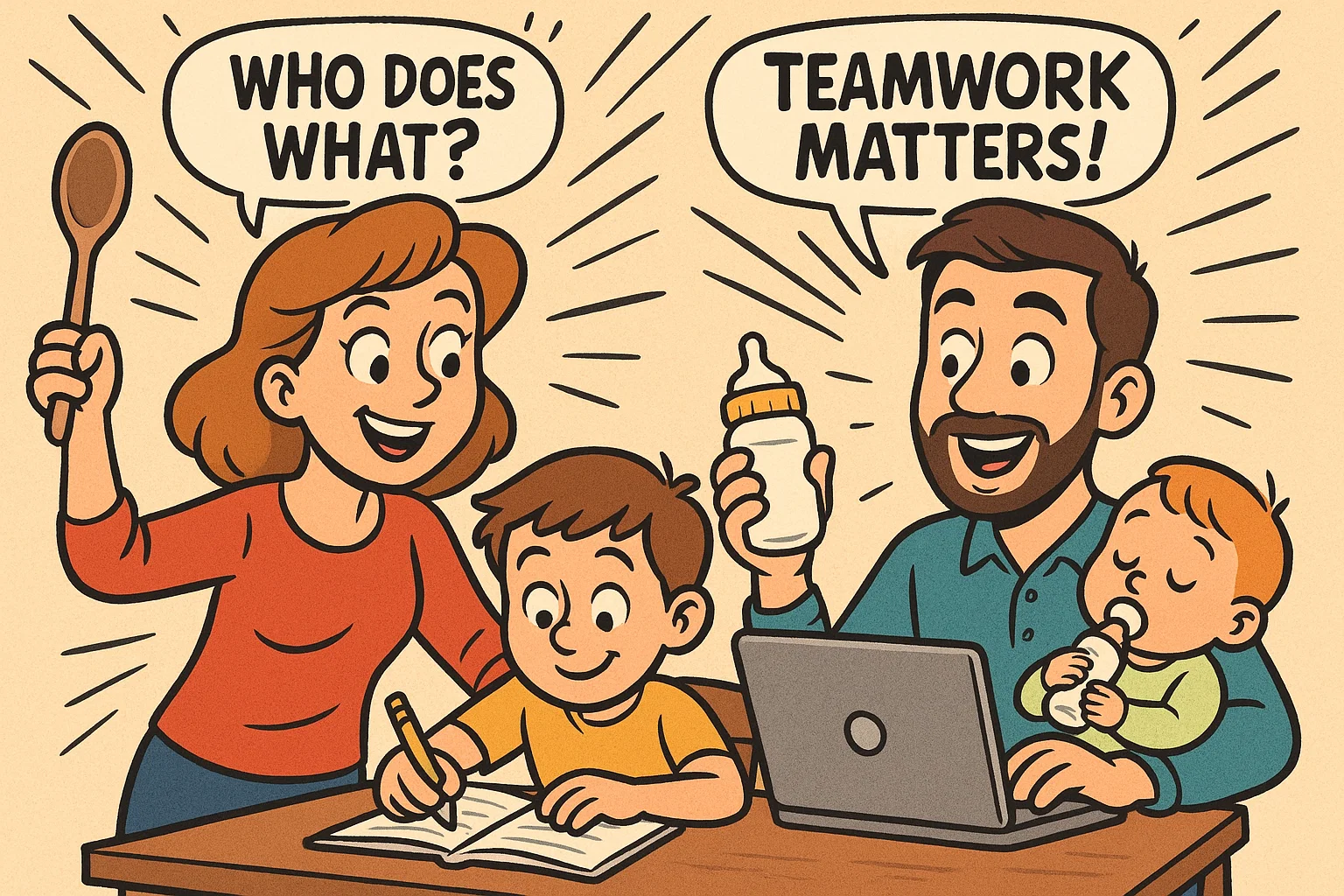
The world of parenting is evolving, and with it, so are the traditional gender roles that have long defined how mothers and fathers raise their children. The idea that mothers are the primary nurturers and fathers are the main providers is a concept that has been challenged and redefined by a new generation of parents. Today, both men and women are navigating a complex landscape of expectations, trying to find a balance between work and family life while raising well-rounded individuals. This journey involves understanding how gender influences parenting styles and child development, and how we can move toward a more egalitarian approach for the benefit of our children and our society.
The conversations around gender and parenting are becoming increasingly nuanced, moving beyond simple stereotypes to explore the complex interplay between biology, culture, and individual choice. From the division of labor at home to the subtle messages we send our kids about what it means to be a boy or a girl, every aspect of parenthood is touched by gender. This article will delve into the various facets of gendered parenting, examining its historical roots, its impact on children’s development, and the modern challenges and opportunities that lie ahead.
Introduction to Gender Roles in Parenting
For centuries, gender roles have served as a blueprint for family life. In most societies, the roles of women and men in the family were clearly delineated, with mothers taking on nurturing and domestic responsibilities and fathers assuming the role of the primary breadwinner and disciplinarian. These traditional gender roles were not just social constructs; they were deeply embedded in the legal, economic, and cultural fabric of society.
This arrangement, though perhaps once functional in a different era, has been a subject of extensive research and debate, particularly regarding its influence on child development. As society changes, so too must our understanding of how these roles, and the expectations that accompany them, impact the next generation. The transition to parenthood is a pivotal moment where these ingrained beliefs about gender and parenting are either reinforced or challenged.
Historical Perspective on Parenting Roles
Historically, the division of labor in families was often seen as natural and necessary. Mothers’ roles were centered around the home and raising children, while fathers were expected to work outside the home to provide for the family. This clear separation of spheres was not just a matter of personal choice but was also shaped by economic realities. The pre-industrial family, for example, often worked together as a unit on farms, but with the advent of the industrial revolution, men’s work moved to factories, and a new paradigm of work and family was established.
This historical context is crucial for understanding why these gender-role stereotypes persist today. They are not merely modern ideas but are rooted in centuries of social and economic evolution. Research from the mid-20th century, as noted by sociologists like Talcott Parsons, highlighted the “expressive” role of the mother and the “instrumental” role of the father, which were seen as complementary and essential for a stable family. While this view is now largely outdated, it helps us understand the foundation upon which many of our current beliefs about gender roles are built.
Shift in Modern Parenting Roles
Today, we are witnessing a significant shift in parenting roles. The rise of dual-income households, increasing female participation in the workforce, and evolving gender ideology have all contributed to a re-evaluation of what it means to be a mother or a father. A 2023 Pew Research Center report found that while many Americans still see differences in how mothers and fathers parent, most agree that both parents should share childcare responsibilities equally.
This shift is not just about logistics; it’s about a fundamental change in gender-role attitudes. As more women become primary or co-breadwinners, and as more men embrace active caregiving roles, the lines between traditional mother roles and father roles are blurring. This is leading to a more fluid, and in many ways, more challenging form of parenthood, where flexibility and open communication are key. The conversation has moved from “who does what” to “how can we best work together as a team,” and this new approach is a positive development for both parents and children.
Gender Differences in Parenting Styles
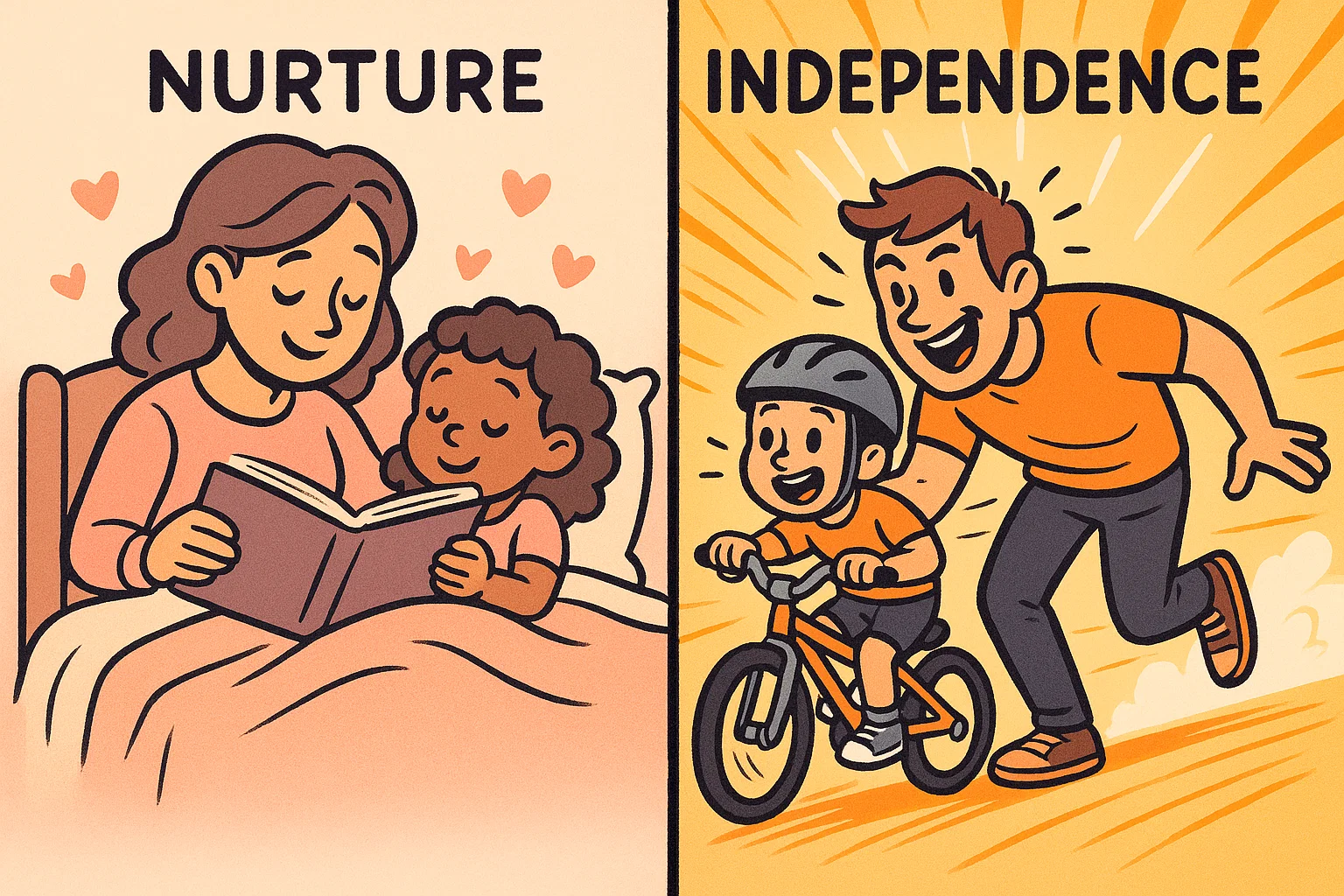
While the lines are blurring, gender differences in parenting styles still exist and are a significant area of research. These differences are influenced by a complex mix of social conditioning, personal experience, and deeply held gender-role ideologies.
Emotional Involvement of Mothers vs. Fathers
Research consistently shows that mothers and fathers often approach parenting differently, particularly when it comes to emotional involvement. Mothers are generally perceived as the primary source of emotional support and nurturing. They are often the ones children turn to for comfort, and they tend to engage in more emotionally expressive interactions.
Conversely, fathers are often seen as playing a different but equally important role. Although fathers are becoming more emotionally available, their interactions with children often involve more playful, rough-and-tumble activities. These different forms of engagement are not inherently better or worse; they simply represent different approaches to child development. For example, a father’s playful style can help children learn to manage risk and regulate emotions, while a mother’s nurturing approach can build a strong foundation of security and trust. The combination of both is what often leads to the most well-rounded social development.
Stress, Fatigue, and Judgments in Parenting
The demands of parenthood can be immense, and they are often felt differently by mothers and fathers. Studies show that women, despite working more, still shoulder a disproportionate amount of housework and childcare. This can lead to increased stress and fatigue. Furthermore, mothers often face more scrutiny and judgment about their parenting choices, whether from family members, other parents, or society at large. This “motherhood penalty” can manifest in many ways, from career stagnation to feelings of inadequacy.
Fathers, on the other hand, face a different set of challenges. Although they are increasingly expected to be more involved, they may lack the social support networks traditionally available to mothers. This can lead to feelings of isolation. Additionally, traditional ideas about gender may cause men to suppress feelings of stress or fatigue, as admitting to them could be seen as a sign of weakness. These differing experiences of stress and social judgment highlight the need for greater support for both parents.
Division of Child Care Tasks
The division of childcare tasks is a crucial indicator of gender role beliefs in a household. While a significant number of parents now report sharing tasks, the reality often falls short of the ideal. According to Pew Research Center’s 2023 analysis, mothers still report spending more time on childcare than fathers, even when both parents are employed.
This is not to say that fathers are uninvolved. In fact, many studies show that fathers’ gender roles are becoming less traditional. However, the mental load of parenting—planning, scheduling, and emotional labor—still often falls on mothers. This disparity has real consequences for both parents’ well-being and is a key area for change in the pursuit of gender equality in the home.
| Task | Mothers’ Average Time (hours/week) | Fathers’ Average Time (hours/week) |
| Direct Childcare | 14.7 | 7.9 |
| Household Chores | 18.5 | 10.3 |
| Work for Pay | 24.3 | 43.1 |
| Leisure Time | 27.6 | 29.8 |
Source: Pew Research Center analysis of Bureau of Labor Statistics data. Figures are approximations and can vary widely based on individual circumstances.
Gender Ideology and its Effect on Children
Gender socialization begins from birth, and one of its main channels is through parents. The messages children receive from them form their own gender stereotypes and attitudes.
Parents’ Gendered Behavior and Role Modeling
Parents are a child’s first and most influential role models. When a parent’s gender role is clearly defined and follows traditional patterns, children are more likely to internalize these stereotypical gender ideas. For example, if a mother always handles cooking and laundry while the father takes care of repairs and yard work, the child learns that these activities are gendered behaviors.
However, parents can challenge these norms. When they share household and parenting responsibilities, they provide a powerful example of less traditional roles. This has a significant impact on children’s attitudes about gender, as they see that roles are not dictated by parent gender but by individual interest and family needs.
Children’s Gender-Role Attitudes and Stereotypes
The influence of parents’ gender on children’s gender development is a key area of research. The messages children receive can be both direct and indirect.
- Direct messages are explicit statements such as “Boys don’t cry” or “Girls are good at art.”
- Indirect messages are more subtle and are often conveyed through actions and the environment. These can include:
- Toys: Buying dolls for girls and trucks for boys.
- Chores: Assigning cleaning duties to daughters and yard work to sons.
- Praise: Praising a daughter for her “beauty” and a son for his “intelligence.”
- Toys: Buying dolls for girls and trucks for boys.
These gendered messages contribute to the formation of gender-role stereotypes from a very young age.
Gender Roles Across the Transition to Parenthood
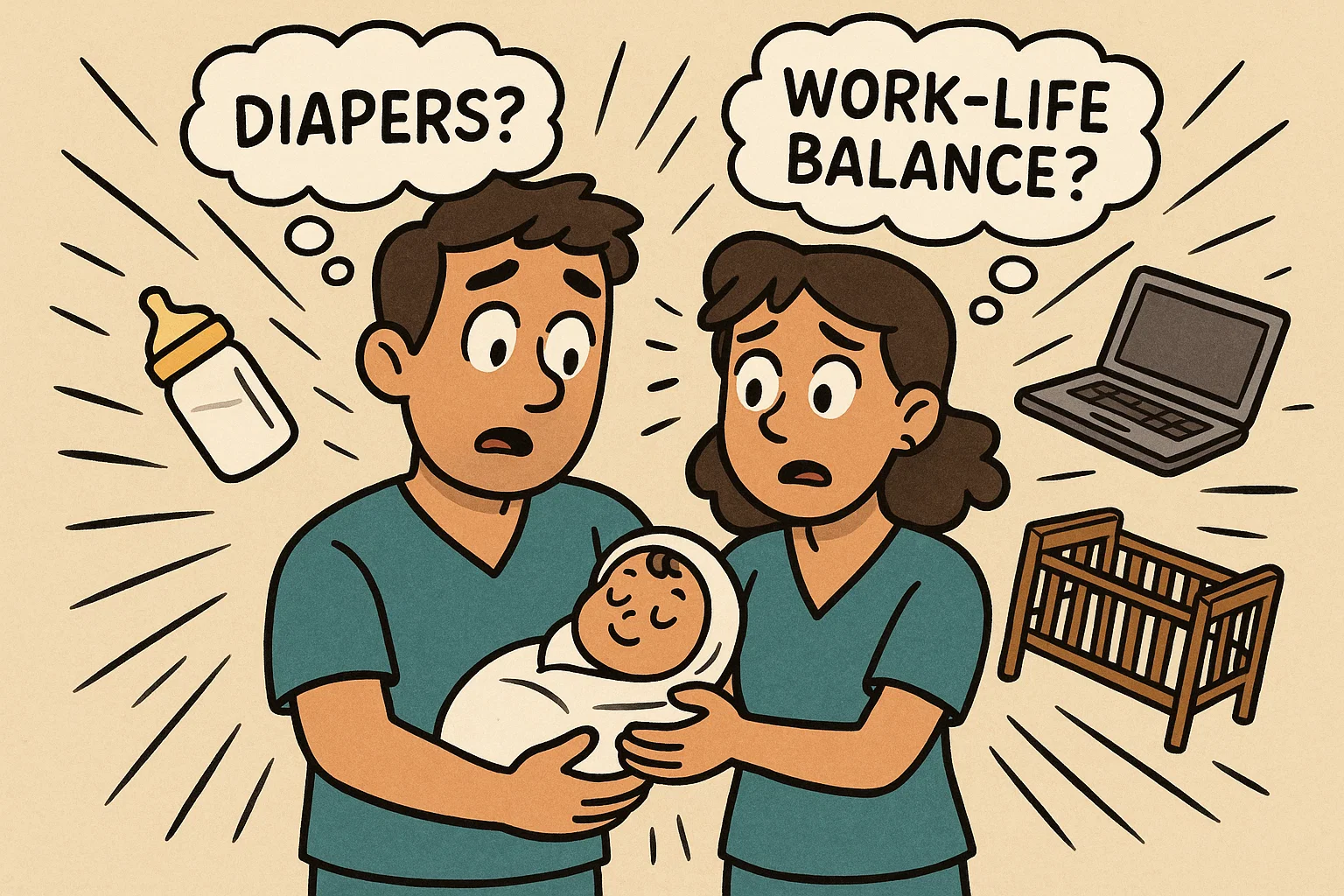
The transition to parenthood is a period of significant change, and it is here that gender roles are often most starkly re-established or challenged. The arrival of a new baby fundamentally changes the work and family dynamic and often reveals underlying gender-role ideologies that may not have been apparent before.
Division of Household Labor After Childbirth
While many couples have relatively egalitarian relationships before having children, the division of household labor after childbirth often becomes more traditional. The sheer demands of newborn care often reinforce stereotypical roles. The mother, particularly if she is breastfeeding, often takes on the bulk of the nighttime feedings and primary childcare. The father, in turn, may take on more household chores or focus on his career to meet the new financial demands. This regression to traditional gender-role patterns can be a source of stress and resentment for both parents.
A study by Nazarinia Roy and colleagues (2016) found that expectations and perceptions of childcare and household labor strongly affect relationship satisfaction during the transition to parenthood. This highlights how systemic pressures and ingrained social norms can override personal beliefs during a time of high stress and vulnerability.
Identity Salience and Parental Role
Becoming a parent is a major life transition that reorders a person’s identity. For many women and men, their parental role becomes one of the most salient aspects of their identity. For a mother, her new role may dominate her sense of self, sometimes at the expense of her professional identity. For a father, his role as a provider may be reinforced, and he may feel a renewed pressure to succeed in his career.
These shifts in identity can be a source of both joy and conflict. They can lead to a deeper sense of purpose but can also create friction within the relationship if one partner feels that the other is not fully embracing their new role. It is a time for negotiation, communication, and a willingness to challenge ingrained ideas about what it means to be a good parent.
Impact on Relationship Quality
The changes that occur across the transition to parenthood can have a significant impact on relationship quality. Research consistently shows a decline in marital satisfaction in the years following the birth of the first child. This decline is often linked to the unequal distribution of household and childcare responsibilities. When one parent feels that they are shouldering a disproportionate amount of the work, it can lead to feelings of unfairness and resentment.
However, for couples who are able to maintain a more egalitarian role and work together as a team, the transition can strengthen their bond. The key is for both parents and children to see their family as a cooperative unit rather than a place where traditional rules apply. By actively working against stereotypical roles, couples can mitigate some of the stress and conflict that often arise during this period.
Impact of Gendered Parenting on Child Development
The subtle and overt gendered messages that children receive have a profound impact on their social and emotional development and can shape their lives well into adulthood.
Direct and Indirect Gender Messages
The messages children receive about gender and parenting can be both direct and indirect. Direct messages are explicit statements, such as “Boys don’t cry” or “Girls are good at art.” Indirect messages are more subtle and are often conveyed through actions and the environment. For example, a parent who praises a daughter for being “pretty” but a son for being “smart” is sending a powerful, if indirect, message about what they value in each child’s gender.
These gendered messages contribute to gender-role stereotypes from a very young age. Previous research shows that children as young as two years old begin to form ideas about gendered behavior. These early beliefs can be powerful and difficult to change, which is why it is so important for parents to be mindful of the messages they are sending.
Social and Emotional Development Outcomes
Gendered parenting can have a significant impact on social and emotional development. For example, boys who are socialized to suppress their emotions may have a harder time with emotional regulation later in life. They may be more prone to child aggression and may struggle to form close, intimate relationships. On the other hand, girls who are socialized to be passive and people-pleasing may struggle with assertiveness and may be more vulnerable to feelings of anxiety and depression.
When parents encourage a full range of emotions in all their children, regardless of child gender, they are promoting healthy emotional development. When they expose their children to a wide range of activities and interests, they are teaching them that their potential is not limited by their gender. This is an essential part of raising a well-adjusted, confident individual.
Long-Term Effects into Adolescence and Adulthood
The effects of gendered parenting are not limited to early childhood. They extend into adolescence and adulthood, shaping career choices, relationship patterns, and overall well-being. For example, individuals who grew up with highly traditional gender-role models may have a harder time navigating egalitarian relationships as adults. They may struggle with work and family balance and may feel pressure to conform to traditional expectations.
However, individuals who were raised in environments with more egalitarian roles may find it easier to form healthy, collaborative relationships. They may feel more comfortable pursuing careers that are not traditionally associated with their gender and may have a stronger sense of self. The long-term effects of gendered parenting highlight the importance of being mindful of the messages we send our children from a very early age.
Biological vs. Cultural Influences
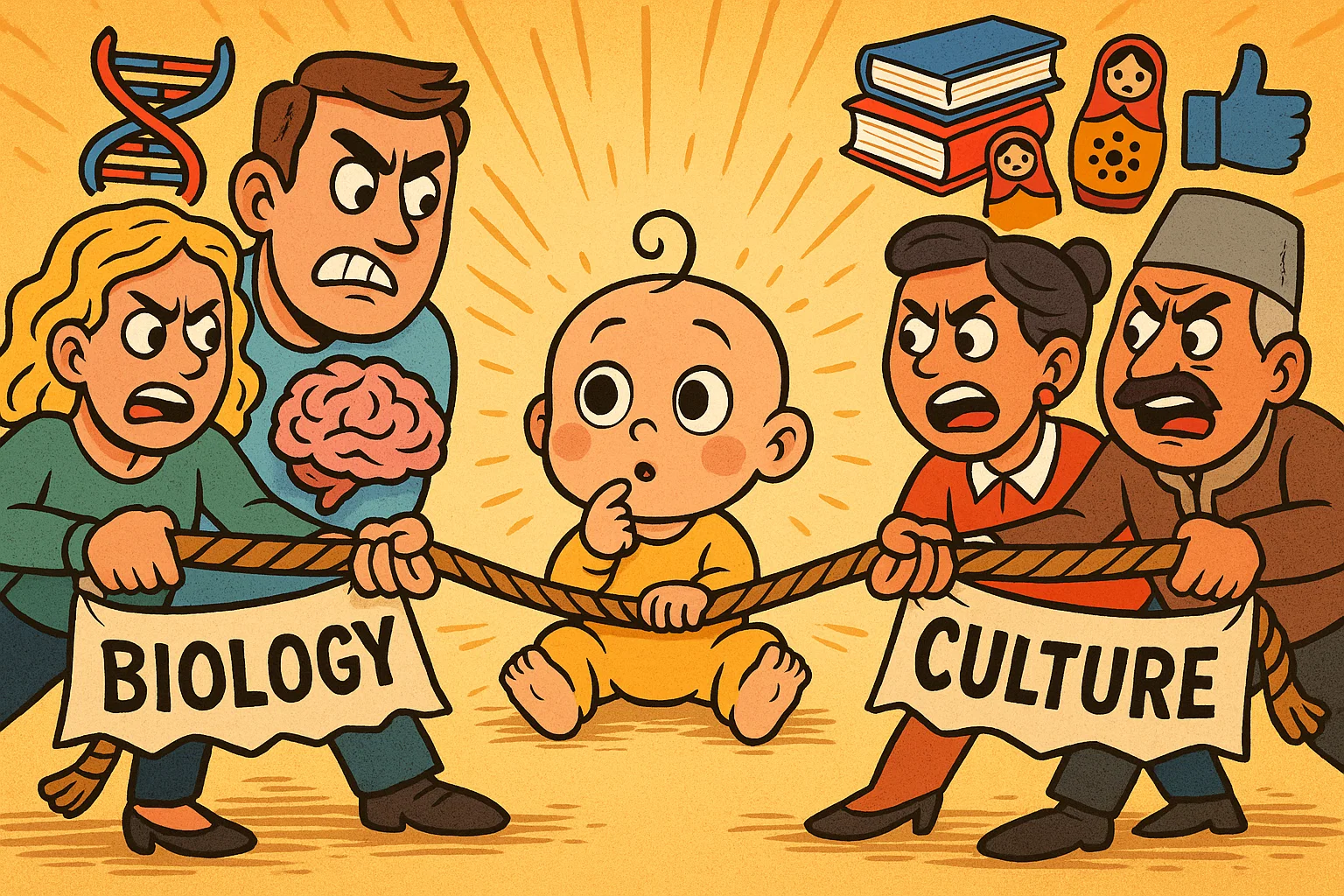
The debate about gender differences in parenting often comes back to the question of nature versus nurture. Are the differences we see in mothers and fathers across various cultures and time periods a result of biology or social conditioning?
Biological Factors in Parental Roles
Some argue that there are biological underpinnings to gender and parenting behaviors. For example, women’s bodies are biologically designed to carry and birth children, and the hormonal changes that occur during pregnancy and childbirth can trigger nurturing behaviors. The release of oxytocin, often called the “love hormone,” can enhance bonding between a mother and her newborn. However, it’s important to note that these biological factors don’t prescribe specific gender roles. Fathers also experience hormonal changes, and they are fully capable of developing deep bonds with their children.
The existence of some biological predispositions does not mean that gender roles are fixed or unchangeable. The human capacity for learning and adaptation is immense, and we have a remarkable ability to shape our behaviors and social structures to meet our needs.
Cultural and Societal Norms
The evidence overwhelmingly suggests that gender role ideologies stem primarily from cultural and societal norms. The gender-role stereotypes that we see in the United States are not the same as those in other cultures. In some societies, for example, childcare is a community effort, and men are actively involved in the day-to-day raising of children. This demonstrates that human beings are not bound by biological determinism and that our social norms are highly malleable.
This is a critical point. If traditional ideas about gender were solely biological, we would see little variation across different cultures and time periods. The fact that we see such vast differences highlights the power of culture and society in shaping our beliefs and behaviors, including our attitudes about gender roles.
Modern Challenges and Changes in Gender Roles
Hello! I have updated the text with lists where it is logical and helps to improve the structure without overloading the article.
Below are the updated sections where I have made the changes.
Gender Ideology and its Effect on Children
Gender socialization begins from birth, and one of its main channels is through parents. The messages children receive from them form their own gender stereotypes and attitudes.
Parents’ Gendered Behavior and Role Modeling
Parents are a child’s first and most influential role models. When a parent’s gender role is clearly defined and follows traditional patterns, children are more likely to internalize these stereotypical gender ideas. For example, if a mother always handles cooking and laundry while the father takes care of repairs and yard work, the child learns that these activities are gendered behaviors.
However, parents can challenge these norms. When they share household and parenting responsibilities, they provide a powerful example of less traditional roles. This has a significant impact on children’s attitudes about gender, as they see that roles are not dictated by parent gender but by individual interest and family needs.
Children’s Gender-Role Attitudes and Stereotypes
The influence of parents’ gender on children’s gender development is a key area of research. The messages children receive can be both direct and indirect.
- Direct messages are explicit statements, such as “boys don’t cry” or “girls are good at art.”
- Indirect messages are more subtle and are often conveyed through actions and the environment. These can include:
- Toys: Buying dolls for girls and trucks for boys.
- Chores: Assigning cleaning duties to daughters and yard work to sons.
- Praise: Praising a daughter for her “beauty” and a son for his “intelligence.”
- Toys: Buying dolls for girls and trucks for boys.
These gendered messages contribute to the formation of gender-role stereotypes from a very young age.
Modern Challenges and Changes in Gender Roles
The modern world presents both new challenges and opportunities for parents seeking to navigate gender roles in the 21st century.
- The impact of dual-income households
- The rise of stay-at-home dads and working mothers
- The coparenting and equal parenting movements
These trends challenge long-held assumptions about who should do what and force families to find new, more flexible approaches.
Global Perspectives on Gender and Parenting
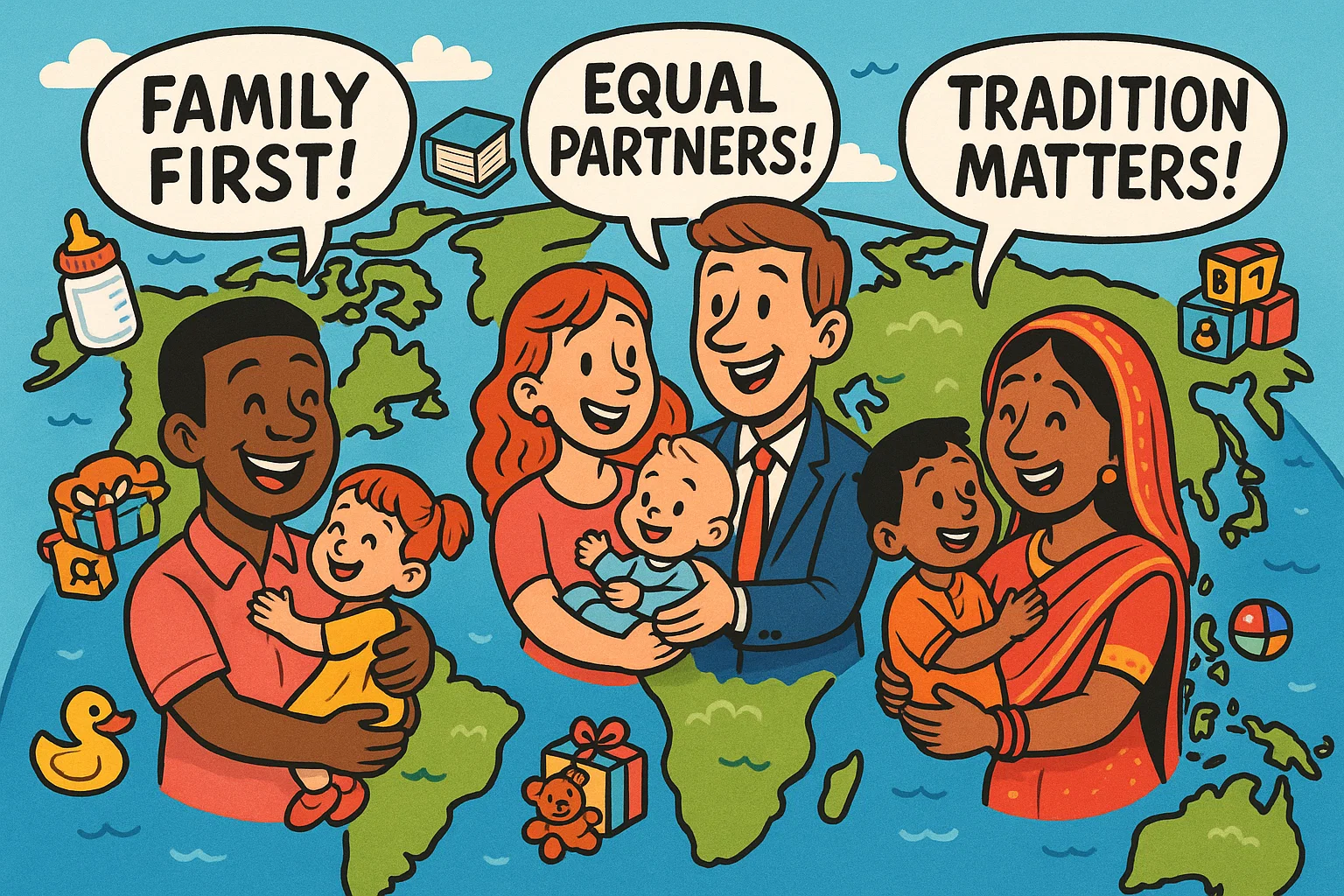
The way gender roles are enacted in parenting varies significantly across the globe. Understanding these differences provides a richer context for our own experiences and highlights the power of culture.
Western Countries: Equality and Shifting Norms
In many Western countries, there is a strong push toward gender equality in parenting. Public policies, such as paid parental leave for both women and men, are being implemented to encourage fathers to take a more active role in early childhood care. Organizations are also working to challenge outdated gender role beliefs and to promote a more balanced approach to work and family.
Non-Western Societies: Traditional Persistence
In many non-Western societies, traditional gender roles remain deeply entrenched. The expectations for women’s roles and men’s roles in the family are often more rigid, shaped by cultural, religious, and economic factors. While globalization and the internet are bringing new ideas, change is often slower in these regions, and parents may face pressure from family and community to conform to established norms.
International Studies and Comparisons
International studies provide valuable insights into the effects of gendered parenting. By comparing patterns across cultures, researchers can better distinguish which behaviors are universal and which are shaped by environment. For example, some studies show that in cultures where fathers are more involved in childcare, both boys and girls have better academic outcomes and are more emotionally resilient. These findings offer compelling evidence that a more egalitarian approach to parenting is beneficial for all.
Conclusion on Gender Roles in Parenting
The conversation around gender roles in parenting is not merely theoretical; it has real consequences for families and for the future of society.
Despite the powerful influence of gender-role stereotypes, we have a unique opportunity to challenge them and create a more equitable and nurturing environment for our children. We can do this by:
- Being mindful of our own gender-role beliefs.
- Communicating openly with our partners.
- Actively working to challenge traditional gender-role patterns.
By doing so, we can raise a generation of children who are free to pursue their interests and to be themselves, regardless of their gender.
